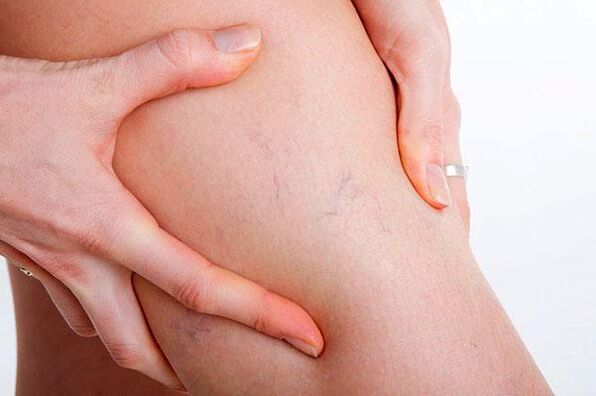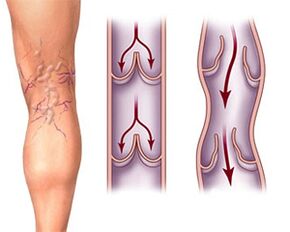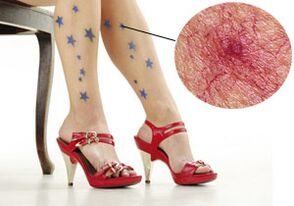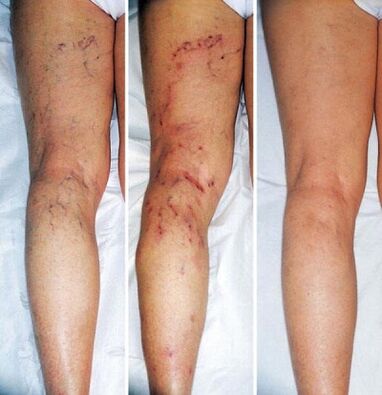
Varicose veins are not only cosmetic defects that appear on the thighs, legs and upper legs in the form of a tree-like blue network, accompanied by pain and spasms in the lower leg muscles when walking or exercising, and a feeling of heaviness. in the leg. First of all, there is a high risk of thrombosis of the inferior vena cava system. This is a serious disease, the symptoms of which affect every fourth person on the planet.
Thrombotic complications lead to the appearance of trophic ulcers on the legs, acute pathologies of blood flow and tissue necrosis of the lower part of the legs. Often, blood clots that break from the walls of vessels that enter the lower leg's circulatory system end their journey through the human circulatory system in the heart or brain. A high risk of stroke or heart attack is the main factor in starting treatment and preventing varicose veins, rather than the unaesthetic appearance of the legs.
Since its inception, the disease is constantly evolving, affecting new areas of the internal and external venous system of the legs. Therefore, it is logical to start analyzing the issue with the prevention of this disease. Competent preventive measures in most cases determine the rate of development of pathology, which develops against the background of hereditary defects in the valvular apparatus of the venous blood flow of the legs.
Prevention of varicose veins
The walls of the lower leg veins are very weak, the muscular system is designed in such a way that it cannot help push the blood through contractions. To control the directional blood flow and prevent its stagnation, veins have special valves. In some people, the valve cannot work properly because of heredity. However, valve pathology can develop with age due to:
heavy physical activity;
increased intra-abdominal pressure;
constipation;
frequent pregnancy.
At first, the process develops in the external veins, but as the disease progresses, it affects the deep venous network. The process of the development of this disease can last for several decades, and the speed depends on the lifestyle, the strength of the blood vessel walls and the intensity of physical activity.
The first task is prevention– minimize the increase in intra-abdominal pressure, avoid increased load and combat constipation.
Second task– promotes the passive outflow of venous blood from the legs. To do this, there is a technique that must be done at the end of the day, or better several times throughout the day. The essence of this technique is to place the outstretched leg on the surface at an angle of 45 degrees relative to the horizontal. You need to lie in this position for at least half an hour. For those who already have varicose veins, it is recommended to sleep with the legs elevated as often as possible.
If you have a disease, you should not use tight shoes and socks with tight elastic bands, so as not to complicate the already affected blood circulation.
Also, when doing sedentary work or just sitting for a long time, you should try to give your legs a horizontal position, and, if possible, put your legs at a height. Naturally, this does not mean that when working in the office you have to sit with your feet on the table. Nope. Try to place something under the table that allows you to rest your legs unobstructed while sitting. You should also avoid the habit of crossing your legs while sitting. At home, you can elevate your legs by placing some pillows.
Conservative treatment
Non-surgical treatment programs consist of diet, medications and compression therapy.
Diet

One of the risk factors for developing varicose veins is being overweight. Therefore, nutrition is one of the treatment factors. Nutrition should be balanced so that the calories received do not exceed the amount needed to meet daily needs. Moreover, the number of calories varies depending on the presence or absence of exercise. You should also remove hot seasonings, marinades, pepper, excess salt, alcohol, smoked foods from your diet, and also eat less fried foods.
The menu should consist of a sufficient amount of vegetables and fruits that contain vitamin C, dishes that contain a large amount of fiber, seafood, and wheat bread. Frequent small meals are recommended. It is important to note that animal fat should be present in moderation. You should not listen to those who say that cholesterol is an absolute evil. Cholesterol in reasonable quantities helps strengthen vascular walls, reducing the risk of vein rupture and recurrent thrombotic deposits.
To quit smoking
Smoking is the most dangerous habit for varicose veins. The fact is that the tar contained in cigarettes clogs blood vessels, and carbon dioxide causes vascular spasms. Smoking increases the risk of blood clots and, as a result, secondary complications such as heart attack and stroke. Smoking is especially dangerous for those who, have varicose veins, take hormonal drugs.
Compression underwear (tights, stockings, knee socks)
This prevention and treatment option is very suitable in the early stages of the disease. Underwear can be selected according to several parameters of pressure on soft tissue, color scheme and model selection. Underwear is worn in the morning, without getting out of bed, until the veins overflow with blood. The main obstacle to the use of this preventive method is the inflated price. Therefore, the main users of knitwear are not those who need prevention, but those who, after surgery, use underwear for secondary prevention purposes.
Varicose veins: treatment with drugs
Medicines cannot cure or stop the disease completely.
Venotonic - ointment and gel

Venotonic aims to strengthen the vein walls, stimulate blood flow and slightly improve microcirculation. These medications, when taken as a course, can reduce pain and swelling. Drug use courses are held twice a year and last at least two months.
Ointments and gels, although safe, are practically useless. They cannot penetrate further than the skin and thus affect the condition of the blood vessels. Ointments and gels are prescribed in the early stages of the disease, when it is not yet known what can remove swelling and heaviness in the legs: medications or postural drainage and the end of physical activity. Sometimes ointment manufacturers are cunning and recommend using the product in combination with tablets.
Ointment based on flavonoid routine.
Ointment containing horse chestnut extract is used twice a day.
gel, the active ingredient is an extract from grape leaves. There are also medicine capsules taken on an empty stomach twice a day.
Venotonic in tablets
Venotonics tablets are used for varicose veins.
Saponin derivatives of the drug are obtained based on horse chestnut, which contains plant bioflavonoids escin. This includes medicine, which exists in the form of drops and tablets.
The most effective preparations are made based on plant flavonoids obtained from citrus fruits - strong venotonics. The course of treatment with these drugs can last up to six months.
Rutosides are the first venotonics. Their effect is to improve microcirculation and have an anti-inflammatory effect.
Natural rutoside, which is available in tablet and capsule form.
Semi-synthetic rutoside.
Combined rutoside. It combines a semi-synthetic derivative of rutin and ginkgo biloba extract. Medicines in capsule form are taken twice a day for a month.
Phlebosclerosing drugs
Allows you to exclude veins from the bloodstream without surgery. The action is achieved through the growth of connective tissue, which gradually closes the lumen of the vessel. Connective tissue is stimulated by increased coagulation of endothelial proteins, as well as irritation of vessel smooth muscle.
Glycosaminoglycan-based ointments containing acidic sulfur, glucocorticoids and non-ionic surfactants are the easiest options. However, the effect is so weak that injection solutions are used.
Synthetic phlebosclerotics.
Products containing iodine or based on animal protein. These drugs are used to selectively close small vessels in the affected vein area. Among doctors, drugs that do not cause vessel thrombosis are popular,
 They only burn the walls at the endothelial level.
They only burn the walls at the endothelial level.
Phlebosclerotic therapy involves drug injections or elastic bandages. This is a relatively simple and painless technique that does not affect the patient's well-being and is quite popular among doctors.
However, isolated sclerotherapy does not provide lasting results and cannot stop the progression of the disease. Therefore, it is better to use it in combination with surgical treatment. Before therapy, it is necessary to undergo an ultrasound of the lower part of the leg to exclude extensive lesions of the saphenous and deep veins.
Contraindications to phlebosclerosis are: allergy to drugs, atherosclerosis of large blood vessels and the presence of ischemia, obliterating endarteritis, diabetic angiopathy, damage to the blood coagulation system, pregnancy, acute thrombophlebitis in the legs.
Additional medication
Agents that improve blood microcirculation: low molecular weight dextrans, purine derivatives. These drugs stimulate the breakdown of platelets, reduce blood viscosity, and increase the elasticity of red blood cells. This process increases the blood supply to the tissue and the oxidative reaction in it.
Anticoagulants of direct or indirect action. Reduces the risk of thrombosis. Popular products in the form of ointments and gels have anti-edematous, anti-inflammatory and antithrombotic effects.
Non-steroidal anti-inflammatory drugs - block the inflammatory process and relieve pain.
Phlebosclerosing therapy options
Before surgery, vein sclerosis is performed to reduce the risk of thrombosis and bleeding in the postoperative period.
During surgery as an alternative to vein removal.
After surgery to close the vein that was not operated on.
The puncture method for administering drugs is used at any time, and the catheter method is used exclusively during surgery.
Puncture method
In addition to the operating room, it can only be performed in a special operating room in compliance with all aseptic rules. Large veins close first, then small ones. Drugs are given from top to bottom. The vein is punctured with the patient in an upright position, and drugs are administered in a horizontal position. If advanced vessel sclerosis is required, the procedure is carried out in several sessions. After the session, the patient is registered with a phlebologist for three years for observation.
After administering the drug, the limb is subjected to an elastic bandage, which is repeated for two weeks. In the first week, the bandage is not removed.
The patient must walk within half an hour of the procedure.
Patients should sleep with their limbs elevated every day and avoid sitting or standing for long periods of time, as well as a lot of walking.
Radiofrequency ablation of veins
Venous ablation using radiofrequency transmitters is an emerging field of phlebology. This method allows you to get rid of varicose veins painlessly, without complications and with minimal risk of vessel injury. Radiofrequency radiation acts on the inner layer of the vascular wall and destroys it. Therefore, the lumen of the vein collapses, and the neighboring tissues are practically unaffected. This is a very effective method.
The procedure is performed under local anesthesia on an outpatient basis. For accuracy during the procedure, control is carried out using duplex angioscanning.
After the anesthetic takes effect, a venipuncture is performed. A catheter with a transmitter is inserted into a vein. It progresses to the point where the saphenous vein joins the deep venous system. With the gradual removal of the catheter, sequential irradiation of the vessel occurs from the inside. After the procedure, the puncture site is treated and covered with a bandage. Special elastic stockings are placed on the feet. After half an hour of walking under supervision, the patient is allowed to go home. If the patient's work does not involve physical labor, he has the right to work the day after the procedure.
Varicose veinsconnectionvein: operation
The merits of surgical intervention are considered by a phlebologist or vascular surgeon. For women who need surgery to correct a cosmetic defect, doctors suggest postponing surgery if they are planning pregnancy. This is due to the fact that during pregnancy, varicose veins develop, and the effects of the operation may be neutralized.
Combined phlebectomy
The most common option to solve the problem of varicose veins using surgery is a combination of phlebectomy. Surgery is performed under general anesthesia or local anesthesia. All incisions are made as small as possible. For example, the great saphenous vein is removed through a one and a half centimeter incision in the groin area. A phlebextractor probe with a special tip is inserted into the vein through the incision. After this, the probe is removed along with the vein. A small vein is removed through a small channel, called a mini-phlebectomy. After surgery, you should use a compression garment.
Endovascular electrocoagulation
Removal of the saphenous vein using current. A more dangerous method than radio frequency destruction and classical surgery.
Cryosurgery
Removal of veins using exposure to low temperatures. This method is quite safe. True, the depth of freezing is not always accurately calculated, which leads to damage to adjacent tissue or incomplete removal of the vein.
Intraoperative scleroobliteration
Use of catheter injection of sclerosing agent into the saphenous vein. Before leg surgery, the saphenous vein and altered venous area are marked. During the operation, the anastomosis of the great saphenous vein and the femoral vein is exposed. A tributary of the great saphenous vein is ligated. At a distance of 1 centimeter from the femoral vein, the saphenous vein is crossed and tied. A catheter is inserted into the severed vein, the vein is sutured, and the wound is bandaged. A gauze roll is placed along the projection of the saphenous vein along the entire length of the leg and pressed. At the same time as pulling out the catheter, a sclerosing agent is injected.
Endoscopic surgery
Transillumination phlebectomy of perforated veins makes it possible to ligate and exclude the vein from the bloodstream. This vein connects the subcutaneous network of veins with the deep network. Endoscopic investigation is used.
Laser freezing
The vein is sealed from the inside with a laser and excluded from the blood stream. Requires a highly qualified doctor and sufficient experience working with lasers.
Home treatment for varicose veins
At home, varicose veins can be treated with tablets, ointments, using leeches, apple cider vinegar and cabbage leaves. Treatment at home can also be done by wearing compression garments or elastic bandages. But if the disease is advanced, no method will help without surgical treatment.
Today, the only high-quality way to get rid of varicose veins is surgical methods, as well as cases combining surgery with sclerotherapy and compression methods.

















